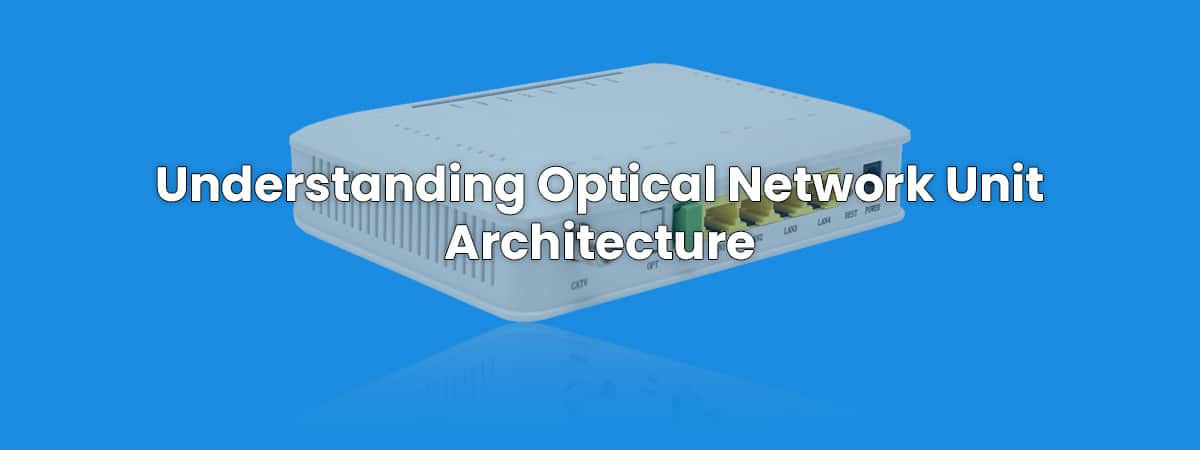Introduction
An optical network unit (ONU) is a type of customer-premises equipment (CPE) used in fiber-to-the-home (FTTH) networks. An ONU allows the service provider to terminate an optical fiber at the customer premises and then convert the optical signal into an Ethernet signal for use on the local network. An ONU can be a stand-alone device or it can be integrated into a home gateway device, such as a router or modem.
An optical network unit is an essential component of any fiber-to-the-home network, and its architecture is critical to ensuring optimal performance. This article will discuss the components of an ONU, the various types of ONUs, and the key design considerations for an ONU architecture.
Components of an Optical Network Unit
An optical network unit consists of several components, including a transceiver, an optical splitter, and an Ethernet port.
The transceiver is responsible for converting the optical signal from the service provider’s network into an electrical signal that can be used by the customer’s network equipment. The transceiver may include components such as a laser diode, an optical amplifier, or a laser driver.
The optical splitter is used to divide the optical signal from the service provider’s network into two or more signals for use on multiple customer networks. The splitter may include components such as a WDM (wavelength division multiplexing) filter, a switch, or an optical amplifier.
The Ethernet port is used to connect the optical network unit to the customer’s local network. The Ethernet port may be a standard RJ45 port, or it may be a Gigabit Ethernet port.
Types of Optical Network Units
There are several types of optical network units, each designed for specific applications.
Passive Optical Network (PON) ONUs are used in point-to-multipoint networks, where a single optical fiber is used to connect multiple customers to the service provider’s network. PON ONUs are often used in FTTH networks, as they are relatively inexpensive and easy to deploy.
Ethernet over Coax (EoC) ONUs are used in networks where the service provider’s network is connected to the customer’s network using an existing coaxial cable. EoC ONUs are particularly useful for customers who already have an existing coaxial cable network, as they can be used to extend the service provider’s network to the customer’s premises without requiring additional cabling.
GPON ONUs are used in point-to-multipoint networks where the service provider’s network is connected to the customer’s network using a Gigabit Passive Optical Network (GPON). GPON is a type of fiber optic network that supports high-speed data rates of up to 2.5 Gbps. GPON ONUs are typically used in FTTH networks, as they are capable of providing high-speed connections to multiple customers.
Design Considerations for an Optical Network Unit Architecture
When designing an optical network unit architecture, there are several key considerations to keep in mind.
The first consideration is power consumption. ONUs are typically low-power devices, so it is important to ensure that the architecture is designed to minimize power consumption. This can be accomplished by using components that have low power requirements, as well as by using power-saving techniques such as power management and sleep modes.
The second consideration is compatibility. It is important to ensure that the architecture is compatible with the service provider’s network, as well as any other networks that may be connected to it. This includes ensuring that the transceiver is compatible with the service provider’s optical network, as well as ensuring that the Ethernet port is compatible with the customer’s local network.
The third consideration is scalability. It is important to ensure that the architecture is capable of scaling to meet the needs of the service provider’s network, as well as the customer’s network. This includes ensuring that the architecture is capable of supporting multiple customers, as well as providing support for future technologies such as high-speed data rates.
Conclusion
An optical network unit is a critical component of any fiber-to-the-home network, and its architecture is essential for ensuring optimal performance. This article has discussed the components of an ONU, the various types of ONUs, and the key design considerations for an ONU architecture. By considering these factors, service providers can ensure that their ONU architecture is optimized for their particular application.
